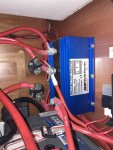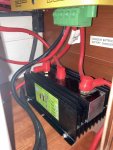Seahorse7101
New Member
Motoring across Lyme Bay and high voltage engine battery alarm sounded. Checked Victron and engine start battery reading 15 volts, domestic reading 14.1 volts. Checked batteries and all connections. Started engine and within a minute alarm went off. Used the linking key/switch so as connect domestic battery to engine start. All voltages returned to normal. With engine running both domestic and engine start charging and reading 14.1 volts. Suspect engine start battery but does anyone have any other ideas? Engine is Volvo D2-75 on a 45’ sailboat.



